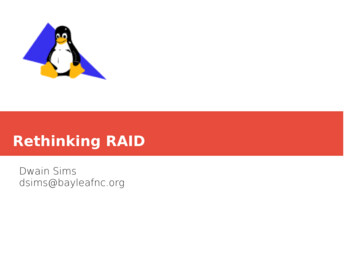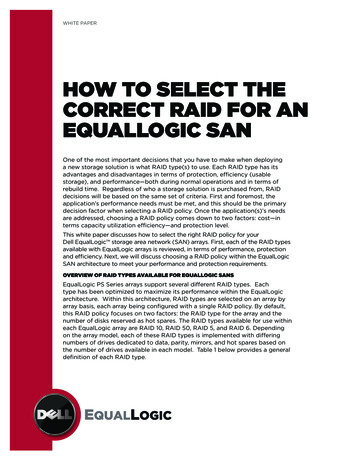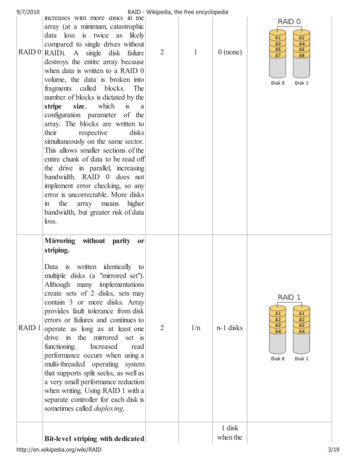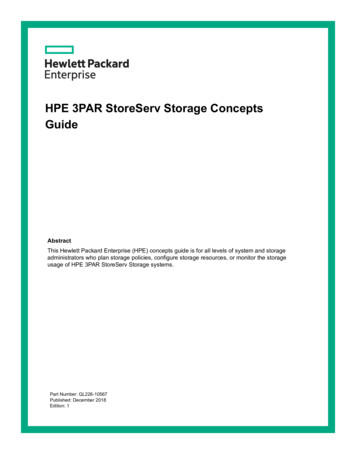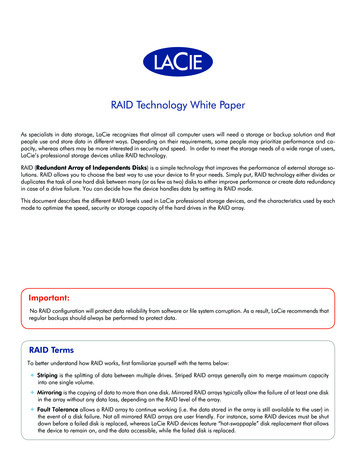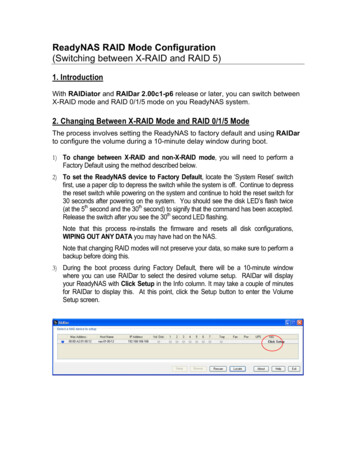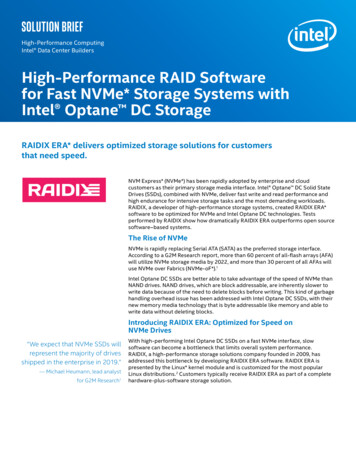
Transcription
Solution briefHigh-Performance ComputingIntel Data Center BuildersHigh-Performance RAID Softwarefor Fast NVMe* Storage Systems withIntel Optane DC StorageRAIDIX ERA* delivers optimized storage solutions for customersthat need speed.NVM Express* (NVMe*) has been rapidly adopted by enterprise and cloudcustomers as their primary storage media interface. Intel Optane DC Solid StateDrives (SSDs), combined with NVMe, deliver fast write and read performance andhigh endurance for intensive storage tasks and the most demanding workloads.RAIDIX, a developer of high-performance storage systems, created RAIDIX ERA*software to be optimized for NVMe and Intel Optane DC technologies. Testsperformed by RAIDIX show how dramatically RAIDIX ERA outperforms open sourcesoftware–based systems.The Rise of NVMeNVMe is rapidly replacing Serial ATA (SATA) as the preferred storage interface.According to a G2M Research report, more than 60 percent of all-flash arrays (AFA)will utilize NVMe storage media by 2022, and more than 30 percent of all AFAs willuse NVMe over Fabrics (NVMe-oF*).1Intel Optane DC SSDs are better able to take advantage of the speed of NVMe thanNAND drives. NAND drives, which are block addressable, are inherently slower towrite data because of the need to delete blocks before writing. This kind of garbagehandling overhead issue has been addressed with Intel Optane DC SSDs, with theirnew memory media technology that is byte addressable like memory and able towrite data without deleting blocks.Introducing RAIDIX ERA: Optimized for Speed onNVMe Drives“We expect that NVMe SSDs willrepresent the majority of drivesshipped in the enterprise in 2019.”— Michael Heumann, lead analystfor G2M Research1With high-performing Intel Optane DC SSDs on a fast NVMe interface, slowsoftware can become a bottleneck that limits overall system performance.RAIDIX, a high-performance storage solutions company founded in 2009, hasaddressed this bottleneck by developing RAIDIX ERA software. RAIDIX ERA ispresented by the Linux* kernel module and is customized for the most popularLinux distributions. 2 Customers typically receive RAIDIX ERA as part of a completehardware-plus-software storage solution.
Solution Brief High-Performance RAID Software for Fast NVMe* Storage Systems with Intel Optane DC StorageRAIDIX has proven its ability to deliver large-scale storagesolutions to meet client needs, including:3 A post-production media company that needed to process4K and 8K raw video files in real timeLocal ClientRemote ClientClient applicationsClient applicationsFile systemsFile systemsHost drivers A city that replaced 2,000 closed-circuit television (CCTV)cameras with high-definition (HD) streaming units andneeded to quadruple its storage capacity A large railway company that needed to perform rapidovernight backup operations at its headquarters and at 16regional computer centers A large high-performance computing (HPC) infrastructurewithin a national academic project that needed 65 PBof storageRAIDIX ERA, the latest software product to emerge fromthe company’s research lab, is a high-performance softwareRAID especially designed for fast protocols like NVMe andfast storage like Intel Optane DC SSDs. Built around parallelinput/output (I/O), lockless architecture, and new methodsof erasure coding, RAIDIX ERA delivers high productivity fordata-intensive applications and works effectively with bothlocal drives and remote drives shared via NVMe-oF. RAIDIXERA provides throughput speeds up to 23 GB per second(GBps) and 5,500,000 I/O operations per second (IOPS) forone RAID 6 group.4Test Results: Intel Optane TechnologyLatency vs. NANDRAIDIX conducted latency and I/O tests comparingperformance of RAIDIX ERA software on an array of fourIntel Optane DC SSDs versus an array of 12 NAND SSDs.Testing included both sequential and random write andread operations for each RAID 5 in various combinations ofblock sizes, queue depths, and write/read percentages. As aresult, the system with four Intel Optane DC P4800X drivesreached 1,043,000 IOPS, while the system with 12 Intel SSDDC D3700 drives reached only 864,000 IOPS. Figure 2 showsa representative cross-section of the latency for random 70percent read and 30 percent write operations with 4K blocksand queue depths from one to eight.The results show lower latency for the Intel Optane DCSSDs, for both read and write operations, and at every I/Odepth. The lower I/O depths show the greatest differencesin latency.Linux* block device: /dev/raidLinux* kernel module: RAIDIX ERA* NVMe* RAIDLinux* block al Back EndRemote Back EndPCIe*NVMe-oF* targetU.2SPDK targetM.2Fibre ChannelInfiniBand*Intel Omni-PathArchitectureLocal Intel Optane DC SSDRemote Intel Optane DC SSDFigure 1. RAIDIX ERA* architecture with Intel Optane DC SSDsIntel Optane Technology:Revolutionizing Memory and StorageIntel Optane technology is a unique combination ofIntel Optane memory media with Intel technology–based advanced system memory controllers, interfacehardware, and proprietary software. Together, thesebuilding blocks deliver a game changing technologythat breaks through storage bottlenecks.Intel Optane technology provides anunparalleled combination of high throughput,low latency, high quality of service (QoS),and high endurance to unleash vast systemperformance potential in a range of products. 5Test Results: RAIDIX ERA vs. MDRAIDvs. ZFS*RAIDIX conducted tests of latency, speed, and throughputfor its ERA software compared to MDRAID and ZFS* ona system using NVMe and Intel Optane DC SSDs.7 Testswere conducted for random and sequential read and writeoperations at seven ratios from 100 percent read to 100percent write and nine block sizes from 4K to 1M.Representative results presented here are for random70 percent read and 30 percent write operations using4K block size.82
Solution Brief High-Performance RAID Software for Fast NVMe* Storage Systems with Intel Optane DC StorageIntel Optane DC SSDs vs. NAND SSDs Latency0.90.8Latency in msec0.70.60.50.40.30.20.1014281284I/O DepthRandom Write 4x Intel Optane DC SSDRandom Write 12x NAND SSDRandom Read 4x Intel Optane DC SSDRandom Read 12x NAND SSDFigure 2. RAIDIX ERA* reads and writes faster on Intel Optane DC SSDs than on NAND SSDs6,7Latency (msec)Average latency in msec129.8110864.674200.61RAIDIX ERA*MDRAIDZFS*Random 70% read, 30% write operationsAverage I/O operations per second (IOPS)Figure 3. Random read/write latency is lower for RAIDIX ERA* than for MDRAID or ZFS*7,8Speed ,000181,500200,000053,700RAIDIX ERA*MDRAIDZFS*Random 70% read, 30% write operationsFigure 4. The total I/O operations per second (IOPS) is higher for RAIDIX ERA* than for MDRAID or ZFS*7,83
Solution Brief High-Performance RAID Software for Fast NVMe* Storage Systems with Intel Optane DC StorageThroughput (MB/s)4,5004,270Average MB per second 0RAIDIX ERA*MDRAIDZFS*Random 70% read, 30% write operationsFigure 5. Throughput is higher for RAIDIX ERA* than for MDRAID or ZFS*7,8By all three measures, RAIDIX ERA significantly outperformedthe open source alternatives. MDRAID performed betterthan ZFS, but RAIDIX ERA achieved more than 5x advantageover MDRAID.Faster Together: RAIDIX ERA, NVMe, andIntel Optane TechnologyThe above results of extensive testing on NVMe systemsshow conclusively that RAIDIX ERA performs at lowerlatency on Intel Optane DC SSDs than on NAND SSDsand that, on Intel Optane DC SSDs, RAIDIX ERA softwareperforms much better than MDRAID or ZFS in termsof latency, speed, and throughput. This new softwaretechnology is well suited to accelerate storage hardwaresystems to new levels of high performance.RAIDIX ERA* is suitable for: Online analytical processing (OLAP) andonline transaction processing (OLTP) Real-time editing of 4K/8K/virtual-reality(VR) video content High-frequency trading (HFT) and real-timebidding (RTB) HPC and technical computing Large SQL and NoSQL database processingLearn more about RAIDIX ERA at raidix.com/products/era/.Learn more about Intel Optane technology atintel.com/optane.4
Solution Brief High-Performance RAID Software for Fast NVMe* Storage Systems with Intel Optane DC Storage1Markets Insider. “G2M Research Releases Fall 2018 NVM Express Market Sizing Report.” December ket-sizing-report-1027784171.2Ubuntu 16.04 LTS*, Ubuntu 18.04 LTS, SUSE Linux Enterprise Server (SLES) 12 SP3*, and CentOS 7.5* are supported. raidix.com/products/era/.3Read detailed case studies on the RAIDIX* blog: raidix.com/blog/.4Tests were conducted October–December 2018 by RAIDIX, using a Western Digital Serv24* system with 2 x Intel Xeon Platinum 8160 processors at 2.10 GHz (Intel Hyper-ThreadingTechnology enabled, С-states disabled), 256 GB DDR4 RAM, and 24 x Ultrastar DC SN620* (3.2 TB/1.2 drive writes per day [DWPD]).5Intel technologies' features and benefits depend on system configuration and may require enabled hardware, software or service activation. Performance varies depending on systemconfiguration. No computer system can be absolutely secure. Check with your system manufacturer or retailer or learn more at intel.com.6Tests were conducted October–December 2018 by RAIDIX. For this test, the following NAND-based server was used for comparison:NAND-based test server specification:7 Intel Server System R2224WFTZS 2 x Intel Xeon Gold 6130 processor at 2.10 GHz with Intel Hyper-Threading Technology enabled, allowing launch of two computing threadsfrom each core All NVM Express* (NVMe*) drives were connected through 3 F2U8X25S3PHS backplanes 12 Intel SSD DC D3700 NVMe drives 1 x 960 GB Intel SSD DC S3520 Serial ATA (SATA) boot drive 1 x 40Gb Intel Ethernet Network Connection XL710-QDA2 384 GB RAM DDR4-2666Tests were conducted October–December 2018 by RAIDIX. Each test loop ran until a steady state was reached, with a maximum of 12 rounds.Test server specification: Intel Server Board S2600WFD 2 x Intel Xeon Gold 6138 processor at 2.00 GHz 4 x 375 GB Intel Optane DC P4800X NVM Express* (NVMe*) drives 1 x 960 GB Intel SSD DC S3520 Serial ATA (SATA) boot drive 1 x 10Gb Intel Ethernet Converged Network Adapter X772 with 10GBASE-T dual-port 1 x 10Gb Intel Ethernet Network Connection OCP X527-DA2 dual-port 1 x 40Gb Intel Ethernet Network Connection XL710-QDA2 384 GB RAMFIO* configurator details for the tests:[global]blocksize [ "4k", "8k", "16k", "32k", "64k", "128k", "256k", "512k", "1m" ]bwavgtime 100000direct 1iodepth [ "1", "4", "8", "32", "64", "128" ]ioengine libaionumjobs 32runtime 120rw [ "randrw", "rw" ]rwmixread [ "0", "10", "30", "50", "70", "90", "100" ]group reporting8To request the complete test results, contact request@raidix.com.Performance results are based on testing as of the date set forth in the configurations and may not reflect all publicly available security updates. See configuration disclosure for details.No product or component can be absolutely secure.Software and workloads used in performance tests may have been optimized for performance only on Intel microprocessors. Performance tests, such as SYSmark* and MobileMark*, are measuredusing specific computer systems, components, software, operations and functions. Any change to any of those factors may cause the results to vary. You should consult other information andperformance tests to assist you in fully evaluating your contemplated purchases, including the performance of that product when combined with other products.For more complete information visit intel.com/benchmarks.Intel does not control or audit third-party benchmark data or the web sites referenced in this document. You should visit the referenced web site and confirm whether referenceddata are accurate.Intel technologies may require enabled hardware, specific software, or services activation. Check with your system manufacturer or retailer.Intel, the Intel logo, Intel Optane, and Xeon are trademarks of Intel Corporation or its subsidiaries in the U.S. and/or other countries.*Other names and brands may be claimed as the property of others. 2019 Intel Corporation.Printed in USA0719/MK/PRW/PDFPlease Recycle340505-001US5
NVM Express* (NVMe*) has been rapidly adopted by enterprise and cloud customers as their primary storage media interface. Intel Optane DC Solid State Drives (SSDs), combined with NVMe, deliver fast write and read performance and high endurance for intensive storage tasks and the most demanding workloads.

